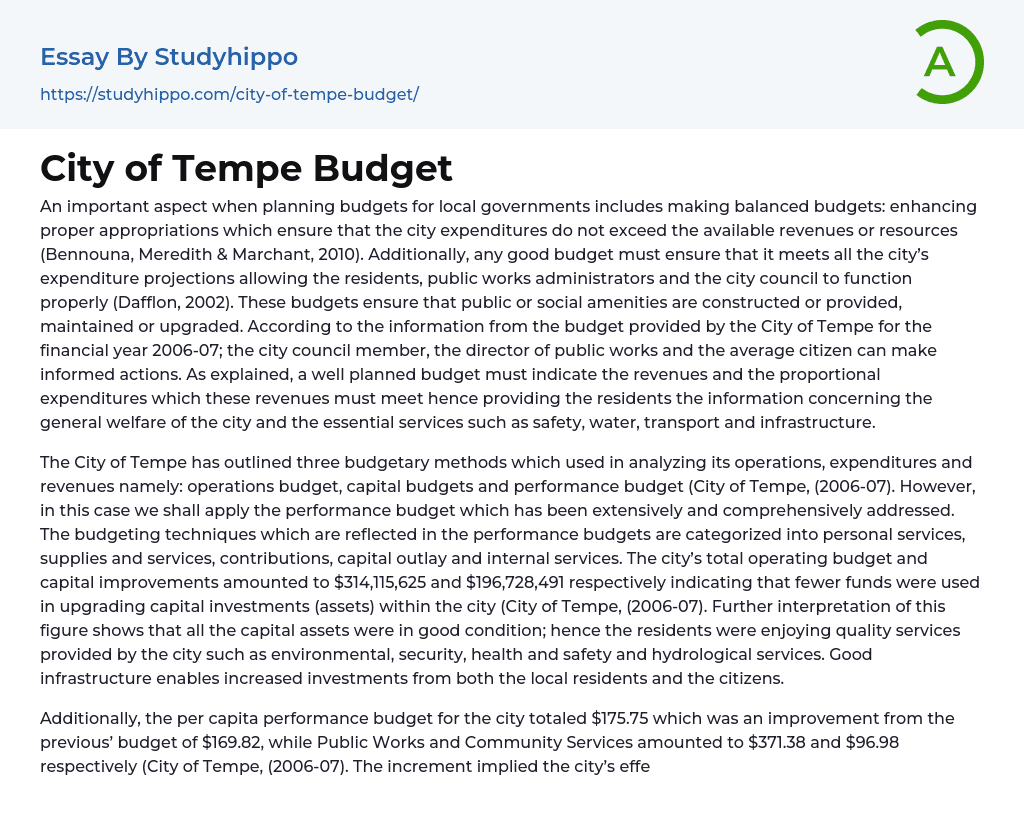An important aspect when planning budgets for local governments includes making balanced budgets: enhancing proper appropriations which ensure that the city expenditures do not exceed the available revenues or resources (Bennouna, Meredith & Marchant, 2010). Additionally, any good budget must ensure that it meets all the city’s expenditure projections allowing the residents, public works administrators and the city council to function properly (Dafflon, 2002). These budgets ensure that public or social amenities are constructed or provided, maintained or upgraded. According to the information from the budget provided by the City of Tempe for the financial year 2006-07; the city council member, the director of public works and the average citizen can make informed actions. As explained, a well planned budget must indicate the revenues and the proportional expenditures which these revenues must meet hence providing the residents the information concerning
...the general welfare of the city and the essential services such as safety, water, transport and infrastructure.
The City of Tempe has outlined three budgetary methods which used in analyzing its operations, expenditures and revenues namely: operations budget, capital budgets and performance budget (City of Tempe, (2006-07). However, in this case we shall apply the performance budget which has been extensively and comprehensively addressed. The budgeting techniques which are reflected in the performance budgets are categorized into personal services, supplies and services, contributions, capital outlay and internal services. The city’s total operating budget and capital improvements amounted to $314,115,625 and $196,728,491 respectively indicating that fewer funds were used in upgrading capital investments (assets) within the city (City of Tempe, (2006-07). Further interpretation of this figure shows that all the capital assets were in good condition; henc
the residents were enjoying quality services provided by the city such as environmental, security, health and safety and hydrological services. Good infrastructure enables increased investments from both the local residents and the citizens.
Additionally, the per capita performance budget for the city totaled $175.75 which was an improvement from the previous’ budget of $169.82, while Public Works and Community Services amounted to $371.38 and $96.98 respectively (City of Tempe, (2006-07). The increment implied the city’s effectiveness in catering and providing services to its residents. The City’s continued prioritization of the general areas of Public Works, Public Safety, and Community Services accounted for 82% of the total departmental budgets (City of Tempe, (2006-07). The budgetary increase in those departments was primarily due to elevated employee compensation, retirement contributions and rising health care costs. The importance of using the different budgeting methodologies adopted by the City ensures strategic issues management which involves identifying, prioritizing as well as managing top priority emerging issues which require interdepartmental coordination (Bennouna, Meredith & Marchant, 2010).
The allocation of funds to the different departments ensures that each department efficiently works towards providing the required amenities and services satisfying the entire City’s residents. In addition, strategic management is made possible as the different emerging issues are addressed accordingly in the respective departments (Horngren et al, 2002). The City’s Water Utilities expenditures are classified by four divisions which include; operations, water resources, administration (CIP management, finance, and aviation) and SROG (Sub-Regional Operating Groups) (City of Tempe, (2006-7). The Operations division had the highest budget of $ 19,079,336 indicating that more funds were used to maintain the City’s activities and services.
Nevertheless, looking into the Water Utilities department’s
budget does not give detailed information on the total budget of the City. Therefore, one has to review the comprehensive budget for the entire City before making any informed decision. Furthermore, these budgeting techniques have their own strengths which enable the various departments to strategically manage any emerging issues which may affect the City. In contrast, the budgeting techniques have a narrowed scope which serves as one of the weaknesses encountered while interpreting each departmental budget (Horngren et al, 2002). Different individuals in the different departments will thus have to analyze the entire budget for the City to make more informed decisions.
References
- Bennouna, K., Meredith, G. G., & Marchant, T. (2010). Improved capital budgeting decision making: evidence from Canada. Management decision, 48(2), 225-247.
- City of Tempe, (2006-07). Annual Budget FY 2006/07. Retrieved from: http://www.tempe.gov/home/showdocument?id=633
- Dafflon, B. (Ed.). (2002). Local public finance in Europe: Balancing the budget and controlling debt. Edward Elgar Publishing.
- Horngren, C. T., Sundem, G. L., Stratton, W. O., Burgstahler, D., & Schatzberg, J. (2002). Introduction to Management Accounting: Chapters 1-17. Prentice Hall.




